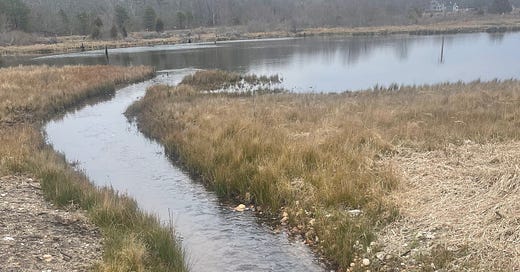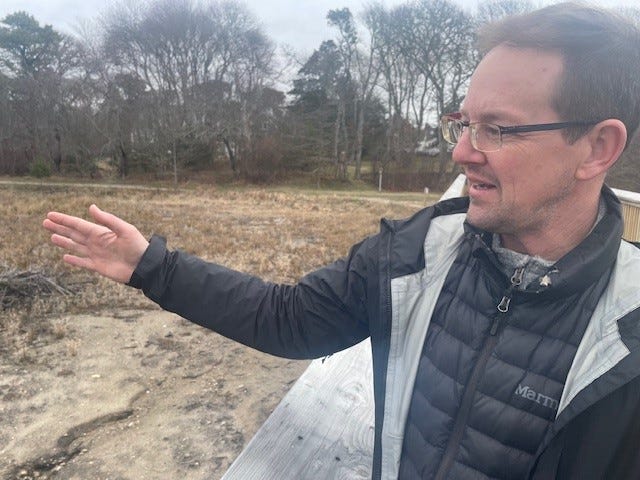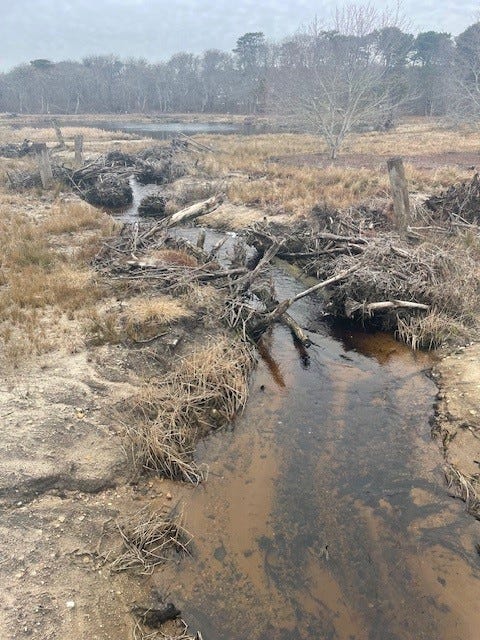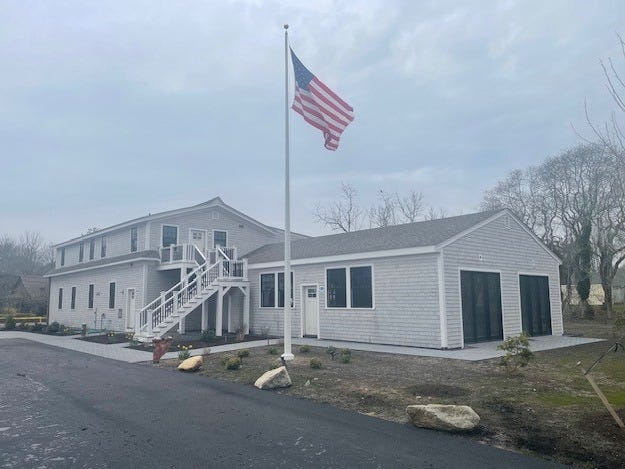A wet, rutted jewel of environmental 'repair'
How a faceted place becomes ‘natural’ -- requiring serious human intervention
One way to gauge success at the 66-acre Robert F. Smith Cold Brook Preserve, wetlands “re-wilding” in Harwich, is that it seems so, well, natural; no obvious evidence of years of design, engineering, earth-churning, millions of dollars invested to transform a moribund cranberry bog.
There are other gauges too. Scores of bird species flit as hundreds of people walk or roll along handsome trails, deer and coyote tracks everywhere, fish finding their way upstream. A brook courses between four ponds, three fresh, one brackish — hard to believe that massive equipment recreated that meandering stream, clawing a sinewy channel through old bog, gouging to seeping groundwater, kettleholing ponds six or seven feet deep.
Then there are gauges yet to be measured. This ecosystem is designed to hold water before it empties into Saquatucket Harbor and Nantucket Sound, to sequester and reduce nitrogen, the same goal as expensive Rube Goldberg big-pipe wastewater infrastructure.
“The idea is that plants and microbes take up nitrogen,” says Harwich Conservation Trust President Tom Evans, hands resting on the railing of one of four wooden bridges. “If Harwich can prove what we believe is the case, every town on the Cape has an opportunity to consider this alternative.” Monitoring equipment pokes out of shallows, gathering evidence.
The Harwich Conservation Trust purchased Carver Crowell’s bog in 2001 intending to keep it active, but couldn’t find a farmer given dire cranberry economics. Mike Lach, the trust’s stalwart executive director, played a key, steady role in a visionary attempt to return the landscape to pre-cultivated status.
The irony? It took a lot of sophisticated engineering and intervention to fashion a “natural” habitat that in some ways never existed.
The most creative eco-role belongs to Harwich native Nick Nelson, who works for a national company called Inter-Fluve. His title is “fluvial geomorphologist,” a mouthful that distills what he does: Design plans to restore wet habitat, or build new ones that might as well be natural.
“I use words like ‘recovery’ and ‘repair,’” says Nelson. “We can’t really get back to what it once was, but we can remove barriers to ecological function, jumpstart eco-systems.”
Nelson grew up along Pleasant Bay, went to Harwich High School, all roots (you might say) for his professional interest. He’s back on old stomping grounds professionally (his folks are still in Harwich), creating one of the first attempts at cranberry bog reinvention in the nation; Inter-Fluve more often removes dams and restores rivers.
Lach cobbled together the funding package; $2 million from the town (justified in part to augment nitrogen removal technology), $1 million from US Fish and Wildlife, $500,000 from the state Division of Ecological Restoration with another $100,000 in state money, almost $500,000 from the town’s Community Preservation Act funds.
When the project first got digging over a year ago, sand was scraped off the surface, then big equipment churned up the bog, turning over peat to allow buried native seeds to surface, uprooting ancient (by Cape standards) cedar stumps and leaving them strewn about. The landscape became chunky, plus or minus one foot in elevation so mini-terrains can encourage different sproutings.
Not everyone was happy.
“People would walk by and say, ‘I don’t understand why nature needs to be ripped apart,’” remembers Nino Corbett, who lives in Houston when he’s not at his Cape home abutting the project. “I would say, ‘No no, it’s just the opposite, they’re taking us back in time, let’s see what happens.’”
“It’s called ‘micro-topography,’” says Jeremy Sanders, a woodworker as well as foreman who handles earth-mauling equipment with almost as much care as turning on a lathe. “The theory is simple: Work with what’s there and flip it over.”
Initial results look ragged, churned, ugly to a conventional landscaper’s eye; one woman walking her dog during first phases said she felt like “she was in Ukraine,” a most unfortunate exaggeration. But then organic magic happens, scars healing over with new growth, earth relaxing.
And as reported by birders like Michelle Burnat from Eastham and “Birdability” (a national organization supporting birders with physical disabilities), stumps create great rest areas for winged travelers.
A mile or so away along Route 124, a second Harwich restoration is underway. Fred Jenkins’ cranberry bog, about 30 acres, was purchased in 2021 and the approach is similar though there will be no brook running from Hinckleys Pond — never was one.
While this project is more than half-done, there is trepidation: Almost $2 million in federal funding was approved, but in this political climate environmental restoration projects are in danger of being orphaned. Billing is going out twice a month instead of once, with results checks cut so far.
“We’re remaining optimistic,” says Lach. “What’s our choice?”
Nelson and Inter-Fluve also are reinventing (repairing? retiring?) old cranberry bogs on the Coonamessett River in Falmouth, Bass River’s headwaters in Yarmouth, Marstons Mills, getting started at Namequoit bog in Orleans. More Cape footprints, step by step.
Back at Cold Brook’s trail head and parking lot, there is a neighboring project:
One of Harwich’s satellite fire stations is transforming into three affordable housing units above a mini-fire museum, with a lower-slung public gathering space where trucks used to garage.
The initiatives are separate, fire station conversion overseen by the Harwich Fire Association, but the synergy speaks to a collective vision:
Environmental restoration and affordable housing can, literally, emerge side by side.
Not a paid subscriber yet? Now’s the time.
Support real local journalism and you’ll receive enterprising reporting, nuanced writing, strong perspectives, unique takes every week from Cape Cod and beyond.
So please, subscribe, keep me going, sharing a Voice:
https://sethrolbein.substack.com/welcome
And if you are into Instagram, want to see some additional material, maybe share the work, here you go:












Seth, during a time when "feel good" news is at a minimum, this exciting overview of Cape environmental projects fills a void. Thanks for this one - it's special. Sam